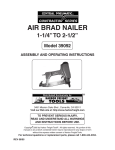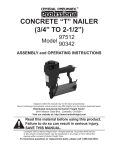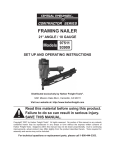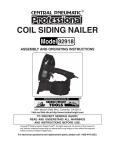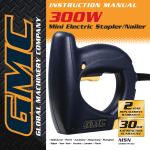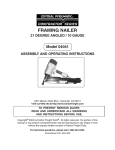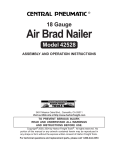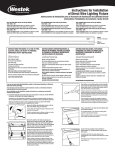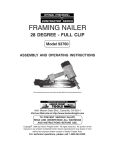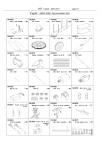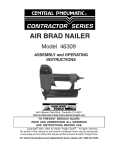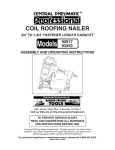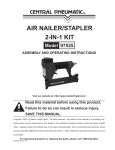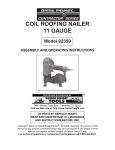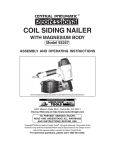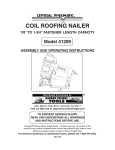Download Harbor Freight Tools 46240-B User's Manual
Transcript
AIR FRAMING NAILER 8-10 GAUGE Model 46240-B ASSEMBLY and OPERATING INSTRUCTIONS 3491 Mission Oaks Blvd., Camarillo, CA 93011 Visit our Web site at http://www.harborfreight.com TO PREVENT SERIOUS INJURY, READ AND UNDERSTAND ALL WARNINGS AND INSTRUCTIONS BEFORE USE. Copyright© 2003 by Harbor Freight Tools® . All rights reserved. No portion of this manual or any artwork contained herein may be reproduced in any shape or form without the express written consent of Harbor Freight Tools. For technical questions and replacement parts, please call 1-800-444-3353 REV 06/04 REV 11/04 Specifications 28o, 0.113” - 0.131” Diameter (8-10 Gauge), 2” - 3-1/2” long Clipped Head Nails Magazine Capacity 90 Air Inlet 1/4”- 18 NPT Recommended Air Pressure 60-125 PSI * Maximum Air Pressure 100 PSI Safety Feature Full Sequential Safety Trip Mechanism This Nailer Features an Adjustable Depth Mechanism, see page 10. Nail Size * The air pressure setting must not exceed job site regulations/restrictions. The air pressure setting must not exceed 90 PSI when being used with work pieces that have a thickness of less than 1-3/4”. Save This Manual You will need the manual for the safety warnings and precautions, assembly instructions, operating and maintenance procedures, parts list and diagram. Keep your invoice with this manual. Write the invoice number on the inside of the front cover. Keep the manual and invoice in a safe and dry place for future reference. Safety Warnings and Precautions WARNING: When using tool, basic safety precautions should always be followed to reduce the risk of personal injury and damage to equipment. Read all instructions before using this tool! 1. Keep work area clean. Cluttered areas invite injuries. 2. Observe work area conditions. Do not use machines or power tools in damp or wet locations. Do not expose to rain. Keep work area well lit. Do not use electrically powered tools in the presence of flammable gases or liquids. 3. Keep children away. Children must never be allowed in the work area. Do not let them handle machines, tools, extension cords, or air hoses. 4. Store idle equipment. When not in use, tools must be stored in a dry location to inhibit rust. Always lock up tools and keep out of reach of children. 5. Use the right tool for the job. Do not attempt to force a small tool or attachment to do the work of a larger industrial tool. There are certain applications for which this tool was designed. It will do the job better and more safely at the rate for which it was intended. Do not modify this tool and do not use this tool for a purpose for which it was not intended. 6. Dress properly. Do not wear loose clothing or jewelry as they can be caught in moving parts. Protective, electrically nonconductive clothes and nonskid footwear are recommended when working. Wear restrictive hair covering to contain long hair. 7. Do not overreach. Keep proper footing and balance at all times. Do not reach over or across running machines or air hoses. 8. Remove adjusting keys and wrenches. Check that keys and adjusting wrenches are removed from the tool or machine work surface before attaching to an air source. REV 11/06 SKU 46240-B For technical questions, please call 1-800-444-3353. Page 2 9. Use eye and ear protection. Always wear ANSI approved impact safety goggles and appropriate hearing protection. Wear a full face shield if you are producing metal filings or wood chips. Wear an ANSI approved dust mask or respirator when working around metal, wood, and chemical dusts and mists. Other people in the work area must also wear ANSI approved impact safety goggles. 10. Maintain tools with care. Keep tools clean for better and safer performance. Follow instructions for lubricating and changing accessories. Inspect tool cords and air hoses periodically and, if damaged, have them repaired by an authorized technician. The handle must be kept clean, dry, and free from oil and grease at all times. Do not operate a tool if any portion of the tool’s operating controls are inoperable, disconnected, altered or not working properly. 11. Disconnect Air Hose and release any built-up air pressure. Never service the Nailer, clear jams, or disassemble with the air hose attached. Always release any built-up air even after disconnecting hose. Disconnect the Nailer when not in use. 12. Avoid unintentional starting. Be sure the trigger is in the Off position when not in use and before plugging in. Do not carry any tool with your finger on the trigger, whether it is attached to an air source or not. Do not point the tool towards yourself or anyone whether it contains fasteners or not. 13. Stay alert. Watch what you are doing, use common sense. Do not operate any tool when you are tired. 14. Check for damaged parts. Before using any tool, any part that appears damaged should be carefully checked to determine that it will operate properly and perform its intended function. Check for alignment and binding of moving parts; any broken parts or mounting fixtures; and any other condition that may affect proper operation. Any part that is damaged should be properly repaired or replaced by a qualified technician. Do not use the tool if the trigger does not operate properly. 15. Guard against electric shock. Prevent body contact with grounded surfaces such as pipes, radiators, ranges, and refrigerator enclosures. 16. Replacement parts and accessories. This product is to be repaired and serviced only by a qualified technician. When this product is serviced, only identical replacement parts should be used. Use of any other parts will void the warranty. Only use accessories intended for use with this tool. Approved accessories are available from Harbor Freight Tools. 17. Do not operate tool if under the influence of alcohol or drugs. Read warning labels if taking prescription medicine to determine if your judgement or reflexes are impaired while taking drugs. If there is any doubt, do not operate the tool. 18. Use proper size and type extension cord. If an extension cord is required, it must be of the proper size and type to supply the correct current to the compressor without heating up. Otherwise, the extension cord could melt and catch fire, or cause electrical damage to the tool. Check your air compressor’s manual for the appropriate size cord. It is also possible that the use of an extension cord may cause your circuit breaker to trip or your panel fuse to break. If this happens, either use the compressor without an extension cord or find a larger amperage circuit to use. SKU 46240-B For technical questions, please call 1-800-444-3353. Page 3 19. Maintenance. The maintenance outlined in the maintenance section should be performed regularly. For your safety, this product should be serviced or repaired regularly only by a qualified technician. 20. Compressed air only. Never use combustible gas as a power source. 21. Do not load nails with the trigger or safety depressed. Unintentional firing may occur. Do not load nails when the air hose is connected to the tool. Always assume that the tool contains fasteners. 22. Disconnect air supply before loading Nailer. Before reloading (or making any adjustments to) the Nailer make sure that the compressed air is disconnected. 23. Fire fasteners into an appropriate work surface only. Do not attempt to fire fasteners into surfaces too hard to penetrate. Do not drive fasteners on top of other fasteners, or at too steep of an angle. Fasteners can ricochet causing personal injury. Never fire the Nailer into the air, or point it toward yourself or another person. Always wear ANSI approved safety goggles during use, maintenance, and reloading. 24. Do not fire fasteners too close to the edge of a workpiece. They may split the workpiece and fly free, causing personal injury. 25. Take caution as some woods contain preservatives such as copper chromium arsenate (CCA) which can be toxic. When stapling or nailing these materials extra care should be taken to avoid inhalation and minimize skin contact. WARNING: Some dust created by power sanding, sawing, grinding, drilling, and other construction activities, contain chemicals known [to the State of California] to cause cancer, birth defects or other reproductive harm. Some examples of these chemicals are: • Lead from lead-based paints • Crystalline silica from bricks and cement or other masonry products • Arsenic and chromium from chemically treated lumber (California Health & Safety Code § 25249.5, et seq. ) 26. Stay within air pressure capacity. Never operate the Nailer above 125 PSI. 27. Hold tool away from head and body. During operation the Nailer may kick back causing injury. 28. Transport Nailer safely. Always disconnect air supply when moving the tool in the workplace. Carry the tool by the handle and avoid contact with the trigger. Note: Performance of the compressor (if powered by line voltage) may vary depending on variations in local line voltage. Extension cord usage may also affect tool performance. Warning: The warnings, cautions, and instructions discussed in this instruction manual cannot cover all possible conditions and situations that may occur. It must be understood by the operator that common sense and caution are factors which cannot be built into this product, but must be supplied by the operator. REV 11/06 SKU 46240-B For technical questions, please call 1-800-444-3353. Page 4 Unpacking When unpacking, check to make sure the parts listed on page 10 are included. If any parts are missing or broken, please call Harbor Freight Tools at the number on the cover of this manual as soon as possible. Warning! Disconnect the Nailer from the air compressor whenever loading or servicing. After disconnecting the Nailer from the air compressor, there could still be enough air pressure to fire the Nailer. Always fire the trigger repeatedly to make sure all of the air is expended. Set Up 1/4” Air Connector (not included) Nailer 1/4” -18 NPT For best service you should incorporate an oiler, regulator, and inline filter, as shown in the diagram above. Hoses, couplers, oilers, regulators, and filters are all available at Harbor Freight Tools. 1. You will need to prepare a 1/4” air connector (sold separately) to connect to the Air Plug (41) on the Nailer. First, wrap the 1/4” air connector (not included) with pipe thread seal tape before connecting to the Air Source Hose (not included). Connect the Air Source Hose to the Air Plug (41). Note: If you are not using an automatic oiler system on your air compressor, before operation, add a few drops of Pneumatic Tool Oil to the airline connection. Remove the air line at the inlet and put 2 or 3 drops of good quality air tool oil into the air fitting each day of use. With heavy, prolonged use, do this at least twice a day. 2. Set the air pressure on your compressor to 60-125 PSI. Do not exceed the maximum air pressure of 125 PSI. Note: About Air Consumption - CFM Air fastening tools are classified as “intermittent use”, and, as such, may be operated by compressors of almost any size. Small, portable units may not be suitable for high volume work, but will satisfactorily power the nailer for work at a slower rate. The air demand of any fastening tool depends largely upon how quickly the tool is to be used. PRESSURE - Use the lowest air pressure that will sufficiently drive the fastener into the wood. This will depend on the density of the wood, and upon the size and length of the nails being used. Vary the air pressure to adjust the driven depth, without exceeding hte maximum air pressure of 125 PSI. 3. Check the air connection for leaks. REV 11/06 SKU 46240-B For technical questions, please call 1-800-444-3353. Page 5 Testing the Full Sequential Safety Trip Mechanism Warning: Even though the nailer should be empty during this procedure, ALWAYS point the nailer at a piece of scrap wood when testing. 1. Make sure the tool is disconnected from the power supply. 2. Completely empty the Magazine (56) of nails. 3. The Nailer should not fire if the Safety (28) is not depressed against the workpiece. 4. Make sure the Trigger (31) and Safety (28) move freely, without sticking. 5. Connect the air supply to the tool at the Air Plug (41). Set the regulator at the recommended 60 to 125 PSI. 6. Test the tool by depressing the Safety (28) against the workpiece without pulling the Trigger (31). The Tool must not cycle (fire). If it cycles (fires), stop immediately and have it repaired by a qualified service technician. 7. Hold the tool away or off of the workpiece. The Safety (28) of the tool should return to its original position. Point the nailer in a safe direction, towards the scrap wood and squeeze the Trigger (31). The tool should not cycle (fire). If the tool fires, stop immediately and have it repaired by a qualified service technician. 8. Depress the Safety (28) against the workpiece and squeeze the Trigger (31). The tool must cycle (fire) only once. Release the Trigger and squeeze it again. The tool must not cycle (fire). With the Trigger held, carefully lift the nailer and press it against the workpiece again. The tool must not cycle (fire). If it fails to perform in the manner explained in bold, have it repaired by a qualified service technician. Use the Correct Type of Nails This nailer uses only “clipped-head” nails, which are collated at an angle of 28°. “Round Head” nails, collated at 22°, are not to be used in this tool, as they will not feed reliably, and may cause premature wear of the driver assembly. Harbor Freight tools offers a variety of compatible fasteners, which are usually collated in strips of 25. Nails from other manufacturers are also widely available from home centers and building supply stores. Please note that some manufacturers offer fasteners packaged for their brand of air nailers, and their nail strips may be longer than the loading slot in this tool. REV 11/06 SKU 46240-B For technical questions, please call 1-800-444-3353. Page 6 Loading Nails ALWAYS WEAR ANSI APPROVED IMPACT SAFETY GOGGLES WHEN RELOADING OR DOING ANY OTHER MAINTENANCE ON THIS TOOL. Other people in the work area must also wear ANSI approved impact safety goggles. Always disconnect the air nailer from the air supply when loading the magazine. Grasp the finger grip at the lower left side of the magazine, and pull the slide firmly back until it latches. (See the photo section below.) Insert a strip of clipped-head nails, point down, into the loading slot on top of the magazine. You may load 3, or more, strips, depending on the size of the nails. When ready, pull rearward on the finger grip to relieve spring tension, and press the magazine latch in to release the slide. Hold the slide grip to allow it to close gently. Photo 1 Photo 3 1. 2. Photo 2 Photo 4 Operating the Nailer Attach the Nailer to the air supply at the Air Plug (41). Start your compressor and check the pressure making sure it is set at the recommended 60-125 PSI and not over the maximum 125 PSI. After reading the following, it is recommended that you get acquainted with this tool by practicing on scrap wood until you are familiar with its characteristics. Always Wear Eye Protection When Using the Air Nailer 3. 4. 5. Turn the Exhaust Cover (4) to direct the air away from the operator. The full sequential trip trigger has a safety device assembled to the nosepiece. The nailer will not fire unless the serrated collar is depressed. Never attempt to defeat this mechanism, and never manually hold it back to shoot nails. To place and shoot a single nail, grip the nailer without touching the trigger, and position the nosepiece on the wood. With your free hand, press down on the top of the nailer. Give the trigger a quick pull and release. REV 11/06 SKU 46240-B For technical questions, please call 1-800-444-3353. Page 7 Anytime any maintenance or repairs are done (including clearing jams), FIRST: 1. 2. 3. 4. 1. 2. 3. 4. Disconnect the Nailer from the air hose. Empty the Magazine (56) completely. Attempt to fire the Nailer into a piece of scrap wood to ensure that it is disconnected and is incapable of firing any brads. Always leave the Magazine (56) open during maintenance. The Magazine is springloaded and may cause parts or a nail to fly out of the Nailer. Clearing Jams Disconnect tool from air hose. Always fire the trigger repeatedly to make sure all of the air is expended from the Nailer. If a nail is jammed in the discharge area, simply remove it with pliers. If a nail is jammed in the magazine, pull the Magazine Slide (47) all the way back to the engaged position. Using a screwdriver, attempt to release the jammed nail by probing either or both of the two openings in the magazine (see photo below) to release the nail. Pull out the jammed nail and the remainder of the nail strip that is still in the magazine. Dispose of the remaining nail strip; it may be bent or damaged in some other way. Reload the magazine with a new nail strip. Pull back on the Magazine Slide (47) and with your other hand pull the tab down on the Slide Release (58), and guide the Magazine Slide (47) back into posiProbe in these areas with a tion. screwdriver to release jammed nails. If you are unable to clear the nail jam using the method prescribed above, the tool should be taken to a qualified service technician for proper servicing. SKU 46240-B For technical questions, please call 1-800-444-3353. Page 8 Troubleshooting Note: Have the following problems repaired by a qualified service technician. Problem Probable Cause Solution Air leaking at trigger valve area. D a m a g e d O - r i n g s i n t r i g g e r v a l v e Replace O-rings. Then, recheck safety trip housing. mechanism. Air leaking between housing and nose. Loose screws in housing, damaged O- T i g h t e n s c r e w s , o r r e p l a c e O - r i n g s o r rings or bumper. bumper. Air leaking between housing and cap. Loose screws or damaged gasket. Runs slowly or has power loss. N a i l e r i n s u f f i c i e n t l y o i l e d , b r o ke n Lubricate as instructed, install new spring, or spring in cylinder cap, exhaust por t in replace damaged internal par ts. cap is blocked. Tighten screws or replace gasket. Worn or dir ty bumper, damaged pushR e p l a c e bu m p e r o r p u s h e r s p r i n g , c l e a n er spring, inadequate air flow, worn or bumper and dr ive channel, check fittings, Nailer skips driving nails. dry O-ring on piston, damaged O-ring replace or lubricate O-rings, replace gasket. on trigger valve, cap gasket leaking. Nails are jammed in nailer nose. Guide on driver is worn. Wrong size or R e p l a c e g u i d e , u s e r e c o m m e n d e d , u n d a m a g e d n a i l s, l o o s e m a g a z i n e o r d a m a g e d n a i l s, t i g h t e n s c r ew s, r e p l a c e nose screws, damaged driver. driver. Nail will not drive down tight. Replace blade, adjust air pressure, check R o u n d e d d r i ve r b l a d e c a u s i n g s l i p spring under cap for broken coils or reduced p a g e, p owe r l o s s, s l ow c y c l i n g a n d l e n g t h , c h e ck i f c a p i n ex h a u s t p o r t i s power loss. restricted. Driving nail too deeply. Worn bumper or piston spacer. Replace either or both par ts. Warning! Disconnect the Nailer from the air compressor whenever loading or servicing. After disconnecting the Nailer from the air compressor, there could still be enough air pressure to fire the Nailer. Always fire the trigger repeatedly to make sure all of the air is expended. Maintenance Warning! Always disconnect the tool from the air compressor and then empty the magazine of nails before attempting to inspect or perform maintenance to the Nailer. The following three maintenance procedures can be done by the user of the tool. 1. Inspect all of the nuts and screws and make sure they are securely fastened. 2. Periodically lubricate the driving mechanism and magazine with a light oil. Wipe down with a clean cloth. Never use gasoline or flammable solvents to clean the tool. 3. Inspect your air compressor according to manufacturer’s instructions. Warning! If you detect any air leaks, power loss, the Nailer skips driving, drives too deep, or not deep enough, take the Nailer to a qualified service technician. SKU 46240-B For technical questions, please call 1-800-444-3353. Page 9 Parts List Part Description Part Description Part Description 1 Screw 21 Bumper 42 Steel Bar 2 0-ring 22 Bumper 43 Screw 4 Exhaust Cover 23 Gasket 44 Catch Cover 5 Screw 24 Piston Guide 45 Screw 6 Exhaust Cover 25 Outlet Site 46 Suppor t 7 Piston Stopper 26 Screw 47 Magazine Slide 8 Washer 27 Spring 48 Nylon Nut 9 Spring 28 Safety 49 Screw 10 Gasket 29 Trigger Valve Set 50 Tail Cover 11 0-ring 31 Trigger 51 End Stopper 12 0-ring 32 Spring Pin 52 Screw 13 Piston Head 33 Spring Pin 53 Screw 14 0-ring 34 Spring Pin 54 Spacer 15 Piston Set 35 Screw 55 Spring 16 Piston Unit 36 Washer 56 Magazine 17 Air Seal 38 Nylon Nut 57 Front Stopper 18 Cylinder 39 0-ring 58 Slide Release 19 Cylinder Plate 40 Tail Cover 59 Ribbon Spring 20 Body 41 Air Plug 60 Handle Grip NOTE: Some parts are listed and shown for illustration purposes only and are not available individually as replacement parts. PLEASE READ THE FOLLOWING CAREFULLY THE MANUFACTURER AND/OR DISTRIBUTOR HAS PROVIDED THE PARTS DIAGRAM IN THIS MANUAL AS A REFERENCE TOOL ONLY. NEITHER THE MANUFACTURER NOR DISTRIBUTOR MAKES ANY REPRESENTATION OR WARRANTY OF ANY KIND TO THE BUYER THAT HE OR SHE IS QUALIFIED TO MAKE ANY REPAIRS TO THE PRODUCT OR THAT HE OR SHE IS QUALIFIED TO REPLACE ANY PARTS OF THE PRODUCT. IN FACT, THE MANUFACTURER AND/OR DISTRIBUTOR EXPRESSLY STATES THAT ALL REPAIRS AND PARTS REPLACEMENTS SHOULD BE UNDERTAKEN BY CERTIFIED AND LICENSED TECHNICIANS AND NOT BY THE BUYER. THE BUYER ASSUMES ALL RISK AND LIABILITY ARISING OUT OF HIS OR HER REPAIRS TO THE ORIGINAL PRODUCT OR REPLACEMENT PARTS THERETO, OR ARISING OUT OF HIS OR HER INSTALLATION OF REPLACEMENT PARTS THERETO. SKU 46240-B For technical questions, please call 1-800-444-3353. Page 10 Assembly Diagram SKU 46240-B For technical questions, please call 1-800-444-3353. Page 11












